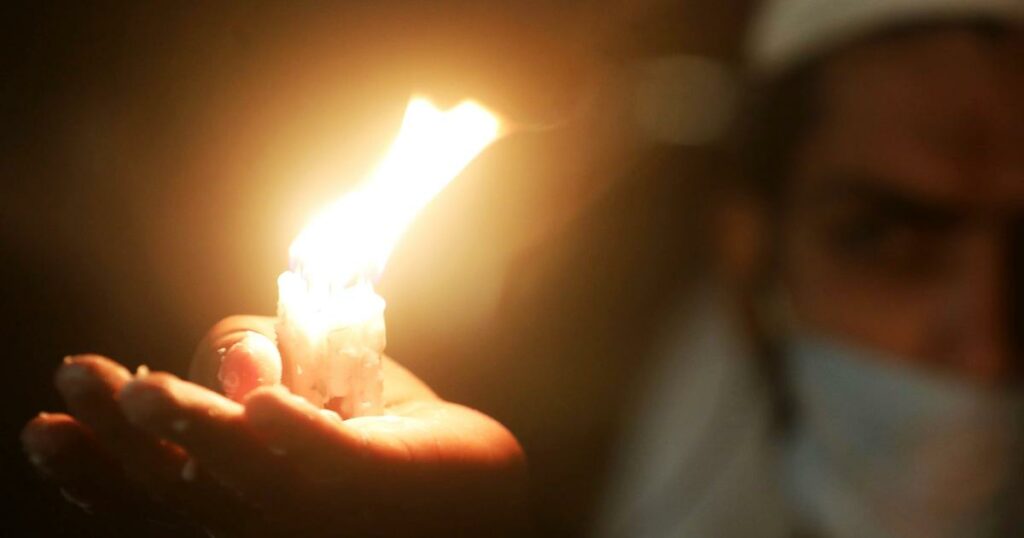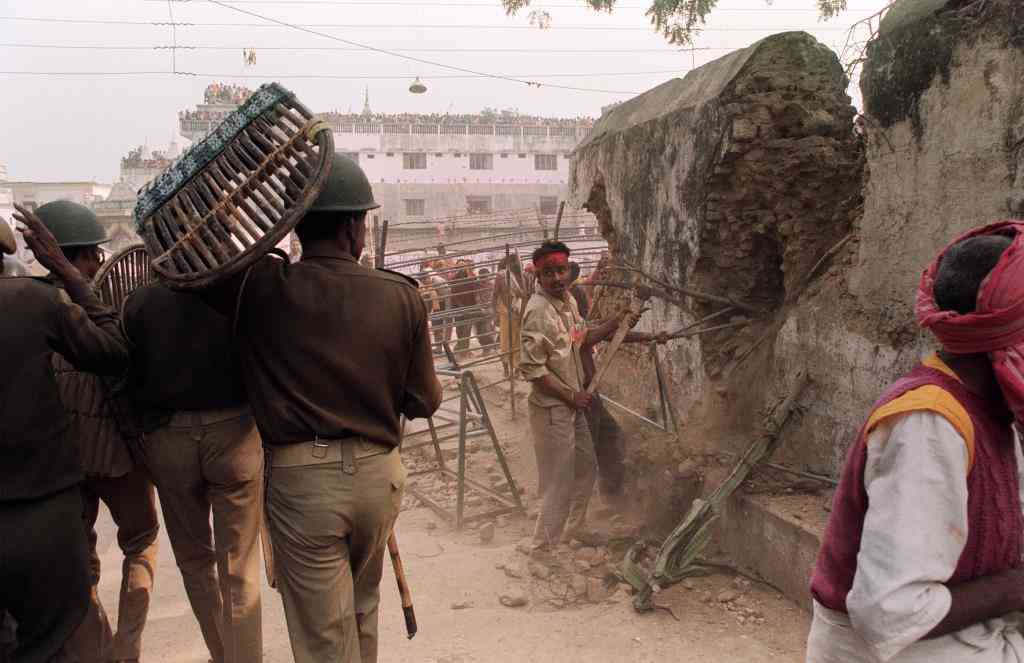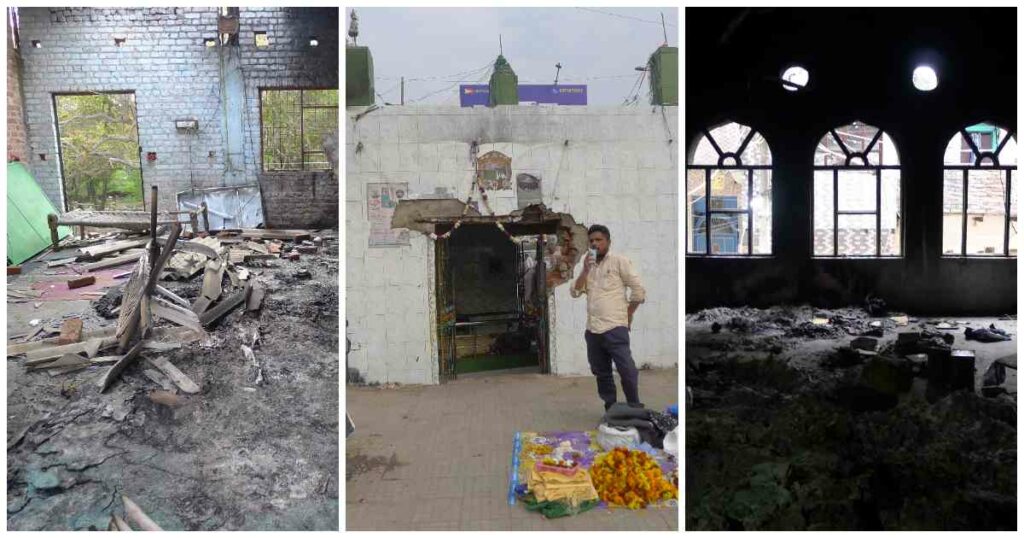India’s Hindu Right Are Willing to Bury Democracy
BRICS, 12 Oct 2020
Arundhati Roy | Scroll - TRANSCEND Media Service
Two Conspiracies and a Cremation
Let’s keep voting for the people who are leading us into penury and war, tearing us apart limb from limb. While India’s rulers downplay the brutal murder of a Dalit teenager by an upper-caste gang and acquit Hindu nationalists guilty of historic crimes, they are concocting another show trial of Muslims and progressive activists to intimidate dissenters.
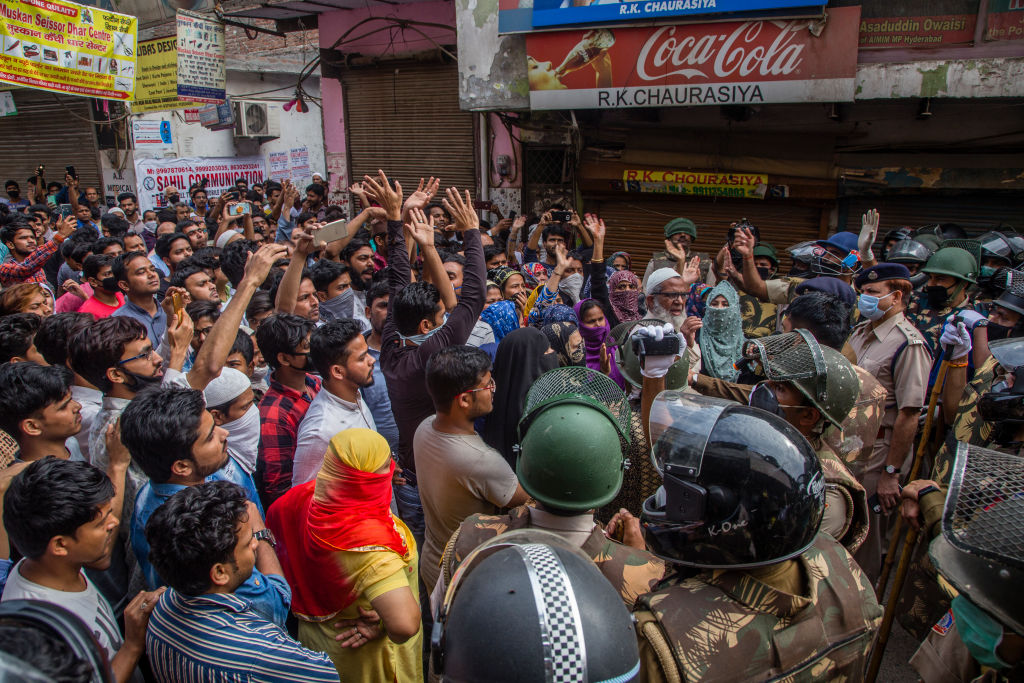
Indian Muslims in an argument with a group of Indian policemen after they were removed from a protest site at Shaheen Bagh on March 24, 2020 in Delhi, India. (Yawar Nazir / Getty Images)
3 Oct 2020 – As Diwali approaches and Hindus prepare to celebrate the triumphant return of Lord Ram to his kingdom (and the spanking new temple that is being built for him in Ayodhya), the rest of us must be content to celebrate this season of serial triumphs for Indian democracy.
Terror Against Dalits
In mid-September, reports came in of a nineteen-year-old Dalit girl who was gang-raped, mutilated, and left for dead by dominant-caste men in her village in Hathras, Uttar Pradesh. Her family was one of fifteen Dalit families in a village where a majority of the six hundred households were Brahmin and Thakur — the same caste as Ajay Singh Bisht, the saffron-robed Uttar Pradesh chief minister who calls himself Yogi Adityanath. (He is, by all accounts, being groomed to replace Narendra Modi as prime minister in the near future.)
The girl had been stalked and terrorized by her assailants for a while. She had nobody to turn to for help. Nobody to protect her. So, she stayed at home and rarely went out. She and her family were aware of what was in store for them. But awareness didn’t help. Her mother found her daughter’s bleeding body in the field where she took her cows to graze. Her tongue had been almost severed, her spine broken, leaving her paralyzed.
The girl survived for two weeks, first in a hospital in Aligarh and then, as her condition worsened, in a hospital in Delhi. On the night of September 29, she died. The Uttar Pradesh police, best known for pulling off four hundred custodial killings last year — almost a fourth of the all-India total of nearly 1,700 — whisked the girl’s body away in the dead of night and drove all the way back to the outskirts of her village.
They locked up the traumatized family, denying the girl’s mother a final farewell, a chance to gaze upon her daughter’s face, and denying the community the dignity of performing the last rites for a beloved who has departed this world. Denying them even the definite knowledge that it was indeed their daughter’s body that was cremated.
The murdered girl’s broken body was laid on a hurriedly put-together pyre, and the smoke rose into the night sky from behind a wall of khaki police uniforms. The girl’s family huddled together, clearly terrified by the blaze of media attention. Terrified because they knew very well that when the lights faded, they would be punished for that attention, too.
If they manage to survive, they will go back to the lives they have grown used to — victims of medieval cruelty and indignity meted out to them in their medieval caste-ridden village where they are considered untouchable and subhuman.
An Ordinary Crime
A day after the cremation, confident that the body had been safely dispatched, the police have announced that the girl had not been raped. She had only been murdered. Only.
This marks the beginning of the standard operating procedure in which the caste angle is quickly excised from caste atrocities. Courts, hospital records, and the mainstream media can all be expected to cooperate in this process of gradually turning a hate-fueled caste atrocity into just another unfortunate but ordinary crime.
In other words, absolving our society, letting our culture and social practices off the hook. We have seen it time and time again, most graphically in the 2006 massacre and brutalization of Surekha Bhotmange and her two children in Khairlanji.
As part of our effort to return our country to her glorious past, as the Bharatiya Janata Party (BJP) promises it will do, in the next election, if you can, please don’t forget to vote for Ajay Singh Bisht. If not him, then for the nearest Muslim-baiting, Dalit-hating politician, whoever he or she may be. Remember to “like” the next lynching video that’s uploaded, and to keep watching your favorite venom-spewing TV anchor, because he or she is the keeper of our collective conscience.
Also, please don’t forget to be grateful that we can still vote, that we live in the world’s largest democracy, and that unlike what we like to call the “failed states” in our neighborhood, in India we have neutral courts that administer the rule of law.
Vanishing Act
Only a few hours after that shameful, horrifying cremation outside the village in Hathras, on the morning of September 30, a Central Bureau of Investigation special court gave us a robust demonstration of just such neutrality and probity.
After twenty-eight years of careful deliberation, it acquitted all the thirty-two people who had been accused of conspiring to demolish the Babri Masjid in 1992, an event that changed the course of the history of modern India. The acquitted included a former home minister, a former cabinet minister, and a former chief minister.
In effect, it appears that nobody demolished the Babri Masjid. At least not legally. Perhaps the mosque demolished itself. Perhaps all those years ago, it picked that day, December 6, Babasaheb Ambedkar’s death anniversary, to hammer itself into dust, to crumble under the collective willpower of the saffron-scarfed thugs who called themselves devotees that had gathered there that day.
It turns out that the videos and photographs we all saw of the men hammering down the old mosque’s domes, the witness testimonies that we read and heard, the news reports that filled the media in the months that followed were figments of our imagination.
L. K. Advani’s Rath Yatra, when he traveled the length and breadth of India in an open truck, addressing huge crowds, shutting down city roads, exhorting true Hindus to converge on Ayodhya and participate in building a Ram temple at the exact spot where the mosque stood — all of that never really happened.
Neither did the death and destruction that his Yatra left in its wake. Nobody chanted Ek dhakka aur do, Babri Masjid tod do. We were experiencing a collective, nationwide hallucination. What were we all smoking? Why aren’t we being summoned by the Narcotics Control Bureau? Why are only Bollywood folks being summoned? Are we not all equal in the eyes of the law?
The Special Court judge has written a detailed 2,300-page judgment about how there was no plan to destroy the mosque. That’s a feat, you have to admit — 2,300 pages about the absence of a plan. He describes how there is absolutely no evidence to say that the accused had met “in a room” to plan the demolition. Perhaps that’s because it happened outside a room, on our streets, at public meetings, on our TV screens for all of us to watch and participate in? Or, heck — is it just that “maal” again, giving us these ideas?
A Committee of Lunatics
Anyway, the Babri Masjid conspiracy is out for now. But there’s another one that’s “in” and “trending.” The conspiracy of the 2020 Delhi massacre, in which fifty-three people (forty of them Muslim) were killed and 581 injured in the working-class neighborhoods of North East Delhi. Mosques, graveyards, and madrassas were specifically targeted. Homes, shops, and businesses, for the most part Muslim, were firebombed and razed to the ground.
In the case of this conspiracy, the Delhi Police charge sheet, which runs into thousands of pages, even has a photograph of a few people sitting around a table — yes! in a room, a sort of office basement — plotting. You can clearly tell by their expressions that they’re plotting. What’s more, there are accusing arrows pointing at them, identifying them, telling us their names. It’s devastating.
Far more alarming than those men with sledgehammers on the dome of the Babri Masjid. Some of the people sitting around the table are already in jail. The rest probably soon will be. The arrests took just a few months. The acquittals could take years — if the Babri judgment is anything to go by, then maybe twenty-eight years, who knows.
Under the UAPA (Unlawful Activities [Prevention] Act), with which they have been charged, almost everything is a crime, including thinking anti-national thoughts. The onus is on you to prove your innocence. The more I read about it and the modus operandi the police adopt around it, the more it sounds like asking a sane person to establish her sanity before a committee of lunatics.
The Delhi conspiracy, we are asked to believe, was hatched by Muslim students and activists, Gandhians, “Urban Naxals,” and “Leftists” who were all protesting against the implementation of the National Population Register, the National Register of Citizens, and the Citizenship Amendment Act, which they believed combine together to cut the very ground from under the feet of the Muslim community and India’s poor who do not have “legacy papers.”
I believe that, too. And I believe that if the government decides to push ahead with that project, the protests will start again. As they should.
A Million-Page Stitch-Up
According to the police, the idea behind the Delhi conspiracy was to embarrass the Indian government by inciting violence and creating a bloody, communal conflagration during US president Donald Trump’s state visit to India in February.
The non-Muslims who are named in the charge sheet are accused of conspiring to give the protests a “secular color.” The thousands of Muslim women who were leading the sit-ins and protests are accused of being “brought in” to give the protests “gender cover.”
All the flag-waving and public readings of the preamble to the Indian Constitution, and the outpouring of poetry and music and love that marked these protests, are dismissed as some sort of insincere fakery designed to disguise malign intent. In other words, the core of the protest is jihadi (and male) — the rest is just garnishing and decoration.
The young scholar Dr Umar Khalid, who I know well, and who has been persecuted, hounded, and fake-newsed by the media for years, is, according to the police, one of the chief conspirators. The evidence they have collected against him, the police say, runs into more than a million pages.
(This is the same government that declared it had no data on the 10 million workers who had to walk hundreds — and some thousands — of kilometers home to their villages in March after Modi announced the world’s most cruel COVID-19 lockdown — no idea of how many died, how many starved, how many fell sick.)
Not included in the 1 million pages of evidence against Umar Khalid is the CCTV footage of the Jaffrabad Metro station — the site of his supposedly egregious plotting and provocation — which activists appealed to the Delhi High Court to preserve, as early as February 25, even as the violence was raging. It has been inexplicably erased.
Umar Khalid is now in jail, along with hundreds of other Muslims who have been recently arrested, charged under the UAPA as well as with murder, attempt to murder, and rioting. How many lifetimes will it take for courts and lawyers to wade through 1 million pages of “evidence”?
A New Generation
Similar to the way in which the Babri Masjid appears to have decided to demolish itself, in the police version of the 2020 Delhi massacre, Muslims conspired to murder themselves, burn their own mosques, destroy their own homes, orphan their own children, all in order to show Donald Trump what a terrible time they’re having in India.
To bolster their case, the police have annexed to their charge sheet hundreds of pages of WhatsApp conversations between students and activists and activist support groups that are trying to support and coordinate between the scores of sites of protests and peaceful sit-ins that had sprung up in Delhi.
It could not be more different from another set of WhatsApp conversations by a group of people who call themselves Kattar Hindu Ekta, or “Hardline Hindu Unity,” in which they actually boast about killing Muslims and openly praise BJP leaders. That is part of a separate charge sheet.
The student-activist conversations are, for the most part, full of spirit and purpose as young people, buoyed by a sense of righteous anger, go about their business. Reading them is energizing and returns you to those heady pre-COVID days and the excitement of watching a new generation come into its own. Time and again, more experienced activists intervene to caution them about the need to stay peaceful and calm. They also argue and bicker in petty ways, as activists tend to — that’s part of the business of being democratic.
The main bone of contention in the conversations, unsurprisingly, is whether or not to try and replicate the stunning success of the protest by the thousands of women of Shaheen Bagh who had, for weeks together, braving the bitter winter cold, squatted on a main road, blocking traffic, creating chaos, but drawing a huge amount of attention to themselves and their cause.
Bilkis Bano, the “Dadi (granny) of Shaheen Bagh,” has made it to Time magazine’s most influential people of 2020. (Don’t confuse her with the other Bilkis Bano, the nineteen-year-old who survived the 2002 anti-Muslim pogrom in Gujarat when Narendra Modi was chief minister of that state. She witnessed a massacre in which fourteen members of her family, including her three-year-old daughter, were killed by a rampaging mob of Hindu vigilantes. She was pregnant and gang-raped. Only.)
Protecting the Guilty
The Delhi activists’ WhatsApp chatter has people divided over whether to go for a “chakka jam” — a road block — in North East Delhi or not. There’s nothing new about planning a chakka jam — farmers have done it time and again. They are doing it right now, in Punjab and Haryana, to protest the recently passed farm bills that corporatize Indian agriculture and threaten to deliver small farmers into an existential crisis.
In the case of the Delhi protests, some activists on the chat groups argued that blocking roads would be counterproductive. Given the climate of open threats by BJP leaders in the area that was fueled by their rage at having been humiliated in the Delhi elections just weeks ago, some local activists feared that blocking roads would incite anger and direct the ensuing violence toward their communities.
They knew that farmers or Gujjars or even Dalits doing it is one thing. Muslims doing it is quite another. That’s the reality in India today.
Others argued that unless roads were blocked and the city was forced to pay attention, the protestors would just be sidelined and ignored. As it turned out, in some protest sites, roads were blocked. As predicted, it gave Hindu vigilante mobs armed with weapons and murderous chants the opportunity they were looking for.
Over the next few days, they unleashed a kind of brutality that took our breath away. Videos showed them being openly backed and supported by the police. Muslims fought back. Lives and property were lost on both sides. But entirely unequally. No equivalence can be made here.
The violence was allowed to swell and spread. We watched in disbelief the spectacle of grievously injured young Muslim men lying on a road surrounded by police who forced them to sing the national anthem. One of them, Faizan, died soon after.
Hundreds of distress calls were ignored by the police. When the arson and slaughter cooled down, and the hundreds of complaints were finally entertained, victims claimed that the police forced them to remove the names and identities of their attackers and the communal slogans raised by the gun- and sword-wielding mobs. Specific complaints were turned into generic ones designed to be inconclusive and protect the guilty. (Hate was excised from hate crimes.)
A One-Party Democracy
On one of the WhatsApp chats, one particular Muslim activist, who lived in North East Delhi and had repeatedly warned the others about the perils of a chakka jam, exited the group after posting a final bitter, recriminatory message. It is this message the police and the media have seized and built upon to spin their sordid web and tar the whole group — among them India’s most respected activists, teachers, and filmmakers — as a set of violent conspirators with murderous intent. Can there be anything more ridiculous?
But it could take years for innocence to be established. Until then, they could be in jail, their lives completely ruined while the real murderers and provocateurs roam free and win elections. The process is intended to be the punishment.
Meanwhile, several independent media reports, citizens’ fact-finding reports, and human rights organizations have held the Delhi police complicit in the violence that took place in North East Delhi. In an August 2020 report, after having had some of the disturbingly violent videos that we all saw forensically examined, Amnesty International said that the Delhi police are guilty of beating and torturing protestors and acting with the mob.
Since then, Amnesty has been accused of financial irregularities and its bank accounts have been frozen. It has had to close its India offices and let go of all 150 of its staff in India.
When things begin to get dire, the first to leave or be forced to leave are international observers. In which countries have we seen this pattern before? Think. Or Google.
India wants a permanent place on the United Nations Security Council, a say in world affairs. But it also wants to be one of the five countries in the world that will not ratify the international covenant against torture. It wants to be a one-party democracy (an oxymoron) with zero accountability.
Burying the Carcass
The real purpose of the absurd police-manufactured 2020 Delhi conspiracy, and the equally absurd 2018 Bhima Koregaon conspiracy (the absurdity is part of the threat and the humiliation) is to imprison and pin down activists, students, lawyers, writers, poets, professors, trade unionists, and noncompliant NGOs. It has to do not just with erasing the horrors of the past and present, but also with clearing the decks for what is still to come.
I suppose we ought to be grateful for these one-million-page evidence gatherings and 2,000-page court judgments. Because they are proof that the carcass of democracy is still being dragged around. It hasn’t been cremated yet, unlike the murdered girl in Hathras, Uttar Pradesh.
Even as a carcass, it’s pulling its weight, slowing things down. The day is not far off when it will be jettisoned and things will speed up. The unspoken slogan among those who rule us may well be Ek dhakka aur do, Democracy gaad do. Bury it.
When that day comes, 1,700 custodial killings in a year will seem like a rosy recollection of our recent, glorious past.
Let that small fact not deter us. Let’s keep voting for the people who are leading us into penury and war, tearing us apart limb from limb.
At least they are building us a grand temple. And that’s not nothing.
_______________________________________________
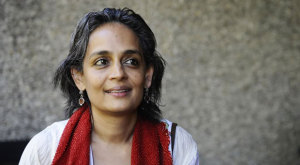 Arundhati Roy, born Nov 24 1961, is an Indian novelist and political activist. She studied architecture in New Delhi, where she now lives. She is the author of the novels The God of Small Things, for which she received the 1997 Booker Prize, and The Ministry of Utmost Happiness. A collection of her essays from the past twenty years, My Seditious Heart, was recently published by Haymarket Books. Roy was awarded the Sydney Peace Prize in 2004 and has concentrated on penning down political issues being a critic of neo-imperialism and linked to anti-globalization movements. Roy’s subversive nature has made her accustomed to criticism. “Each time I step out, I hear the snicker-snack of knives being sharpened but that’s good. It keeps me sharp”, she said when interviewed by an Indian magazine.
Arundhati Roy, born Nov 24 1961, is an Indian novelist and political activist. She studied architecture in New Delhi, where she now lives. She is the author of the novels The God of Small Things, for which she received the 1997 Booker Prize, and The Ministry of Utmost Happiness. A collection of her essays from the past twenty years, My Seditious Heart, was recently published by Haymarket Books. Roy was awarded the Sydney Peace Prize in 2004 and has concentrated on penning down political issues being a critic of neo-imperialism and linked to anti-globalization movements. Roy’s subversive nature has made her accustomed to criticism. “Each time I step out, I hear the snicker-snack of knives being sharpened but that’s good. It keeps me sharp”, she said when interviewed by an Indian magazine.
Tags: Arundhati Roy, Conflict, Hinduism, India, Islam, Muslims, Narendra Modi, Violent conflict
DISCLAIMER: The statements, views and opinions expressed in pieces republished here are solely those of the authors and do not necessarily represent those of TMS. In accordance with title 17 U.S.C. section 107, this material is distributed without profit to those who have expressed a prior interest in receiving the included information for research and educational purposes. TMS has no affiliation whatsoever with the originator of this article nor is TMS endorsed or sponsored by the originator. “GO TO ORIGINAL” links are provided as a convenience to our readers and allow for verification of authenticity. However, as originating pages are often updated by their originating host sites, the versions posted may not match the versions our readers view when clicking the “GO TO ORIGINAL” links. This site contains copyrighted material the use of which has not always been specifically authorized by the copyright owner. We are making such material available in our efforts to advance understanding of environmental, political, human rights, economic, democracy, scientific, and social justice issues, etc. We believe this constitutes a ‘fair use’ of any such copyrighted material as provided for in section 107 of the US Copyright Law. In accordance with Title 17 U.S.C. Section 107, the material on this site is distributed without profit to those who have expressed a prior interest in receiving the included information for research and educational purposes. For more information go to: http://www.law.cornell.edu/uscode/17/107.shtml. If you wish to use copyrighted material from this site for purposes of your own that go beyond ‘fair use’, you must obtain permission from the copyright owner.
